The retrieval, curation and redeposition of human heads – either the entire skull (i.e. cranium and mandible), or simply the cranium (without the mandible) – is a common feature of Near Eastern Neolithic mortuary practices1. In some cases, the facial features were modelled in plaster or mud, and bivalve or cowrie shells were set into the eye sockets to provide a life-like appearance. Some of the most well-known examples of plastered skulls/crania are from Jericho in Palestine and ‘Ain Ghazal in Jordan. Modified skulls have also been found at other sites such as Beisamoun, Kfar-HaHoresh and Tell Ramad in the Levant, as well as at Köşk Höyük in central Anatolia. While some have argued that this practice is a form of trophy collection, likely from dead enemies2, the traditional view holds that skull collecting in the Neolithic represents a form of ancestor veneration, possibly linked to emerging sedentism and the control of local resources3,4,5. More recently, however, researchers have begun to question the interpretation of ancestor worship as evidence mounts from other sites that skull collection and modification was not reserved strictly for older adults, i.e. elder members of society6,7,8,9,10.
Secondary deposits of unmodified skulls and crania are also commonly found at these and other Near Eastern sites, including Çatalhöyük. These may be found in open spaces, house floors and other non-burial contexts, or redeposited in pits individually or in caches. At Çatalhöyük, loose crania and other skeletal elements are often encountered within the grave fill of primary burials, although in some cases they represent the disturbance of earlier burials in the same location. In the above photo, however, the cut for the primary skeleton has not disturbed any earlier burials; thus, the two disarticulated crania and infracranial remains visible in the grave fill must have been intentionally placed with the primary burial. A correlate of these secondary depositions, of course, is the occurrence of headless primary burials, the skulls of which have presumably been removed for the purpose of curation and eventual redeposition. In most cases it appears that the skulls have been removed at some point after interment when the body has either partially or completely skeletonized. This interpretation is based on the lack of cut marks found on the cervical vertebrae or cranial bases.
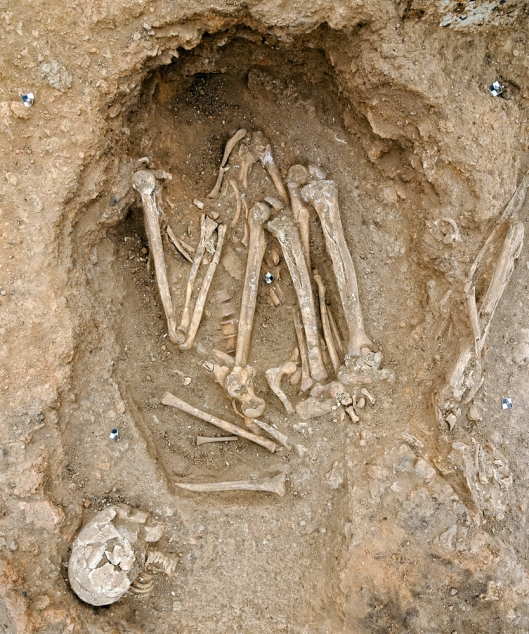
Headless adult primary burial from the North Area at Çatalhöyük. The disarticulated skull, cervical vertebrae and upper ribs from a juvenile are visible in the lower left of the picture.
In 2004 at Çatalhöyük, a plastered skull (cranium and mandible) was discovered cradled in the arms of an old adult female (see picture below). The eyes and nose were carefully modelled and the plaster was painted with red ochre. Unfortunately, the poor state of preservation prevents us from making a definitive sex assessment, but the observable skull morphology indicates a possible female.
To most observers, the seemingly tender manner in which the plastered skull is held in the arms of the older female – face to face – makes it easy to imagine some form of emotional attachment involved – perhaps familial? The skull has been repainted on several occasions and bears other indications of long term curation before it was re-buried with the primary skeleton. Is this plastered skull directly related to the older female, or is it a sort of heirloom, collected at some point in the unremembered past and handed down over generations without any familial relationship necessary? How long was this skull in circulation, and why was it reburied with this particular individual? DNA analysis may tell us about the genetic relationship between the two individuals, and the current application of Bayesian statistics to the radiocarbon dating program at Çatal could provide an indication of the age of the bones. If the plastered skull is much older than the primary skeleton we would have direct evidence for the amount of time it was curated. Ideally, such analyses will be conducted in the future on many of the unmodified crania found on site as well, although there is no guarantee that ancient DNA can be successfully extracted from the skeletal material at Çatalhöyük.
At the time, this discovery was the first evidence at Çatalhöyük for the plastering of human skulls. Red-painted crania have been found by Mellaart in the 1960s and also during the current excavations, but none had been plastered. Identification of the red pigments applied to the crania has been conducted using pXRF technology and demonstrates that red ochre is most commonly used, followed by cinnabar (mercury sulfide). One such cranium was found by Mellaart in the 1960s in grave fill underneath a house floor. Cinnabar had been painted directly onto the cranium in thick, broad bands.
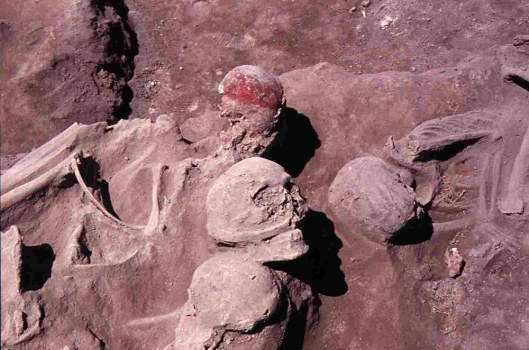
Redeposited cranium (centre) painted with cinnabar found at Çatalhöyük in the 1960s. See here for a more recent picture of this cranium taken during pXRF analysis in 2009.
Now, after seven years, I believe we’ve found tantalising evidence of a second painted and plastered skull at Çatalhöyük. It comes in the form of a disarticulated mandible found in a post-retrieval pit in Building 89. Based on its morphology, the mandible appears to belong to a female (see below). The antemortem (prior to death) loss of the posterior dentition and subsequent resorption of the tooth sockets indicate an adult of advanced age – also note the severe bilateral temporomandibular joint (TMJ) disease on the articular condyles. When the soil was carefully removed from the bone, red pigment (probably ochre) was clearly visible on the body and rami of the mandible (it is less visible in the pictures below). Even more interesting, however, is the thick band of plaster which covers the anterior dentition. It’s clearly been applied intentionally. It’s possible that this mandible was originally attached to a similarly modified cranium, not unlike the one found in 2004. If so, it’s unclear how it became separated from the cranium, or why it seems to have ended up as part of a building closure deposit and not re-interred in the grave fill of a primary burial. Certainly, though, this discovery provides new evidence and – at the same time – raises more questions about the secondary mortuary treatment of skulls at Çatalhöyük.
Postscript: This will be my last post written from Turkey in 2012. After nine long weeks I’m heading back to the UK for some well-deserved rest and as many pork-based food products as I can fit into my mouth. I will, however, continue to post about Çatal and other bioarchaeological topics from home (after the pork, though).
1Bienart, H-D. (1991) Skull cults of the prehistoric Near East. Journal of Prehistoric Religion. 5:9-23
2Testart, A. (2008). Des crânes et des vautours, ou la guerre oubliée. Paléorient 34(1):33-58. LINK
3Kenyon, K.M. (1956). Jericho and its setting in Near Eastern history. Antiquity 30(120):184-197. LINK
4Cauvin, J. (1978) Les Premiers Villages de Syrie-Palestine du IXeme au VIIeme Millionaire Avant J.C. Lyon: Maison de l’Orient.
5Goren, Y., A.N. Goring-Morris & I. Segal (2001). The technology of skull modelling in the Pre-Pottery Neolithic B (PPNB): regional variability, the relation of technology and iconography and their archaeological implications. Journal of Archaeological Science 28:671-690 DOI: 10.1006/jasc.1999.0573
6Bonogofsky, M. (2005). A bioarchaeological study of plastered skulls from Anatolia: new discoveries and interpretations International Journal of Osteoarchaeology 15(2):124-135 DOI: 10.1002/oa.749
7Verhoeven, M. (2002). Ritual and ideology in the Pre-Pottery Neolithic B of the Levant and Southeast Anatolia Cambridge Archaeology Journal 12(2): 233-258 DOI: 10.1017/S0959774302000124
8Kuijt, I. (2008). The regeneration of life. Neolithic structures of symbolic remembering and forgetting Current Anthropology 49(2): 171-197 DOI: 10.1086/526097
9Özbek, M. (2009). Remodeled human skulls in Köşk Höyük (Neolithic age, Anatolia): a new appraisal in view of recent discoveries Journal of Archaeological Science 36:379-386 DOI: 10.1016/j.jas.2008.09.032
10Bonogofsky, M. (2003). Neolithic plastered skulls and railroading epistemologies Bulletin of the American Schools of Oriental Research 331:1-10 DOI: 10.2307/1357755

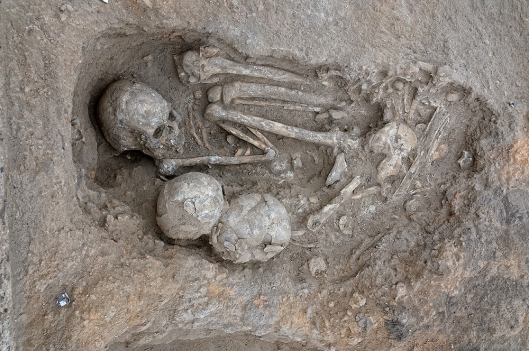
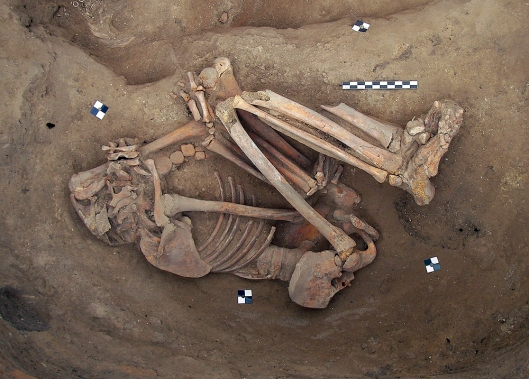
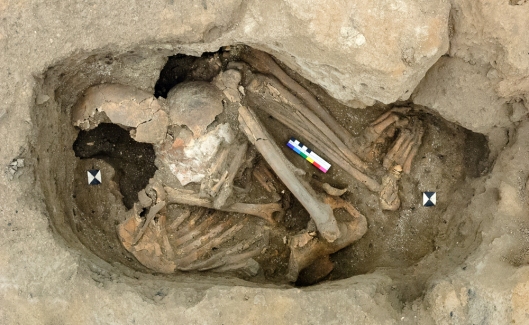
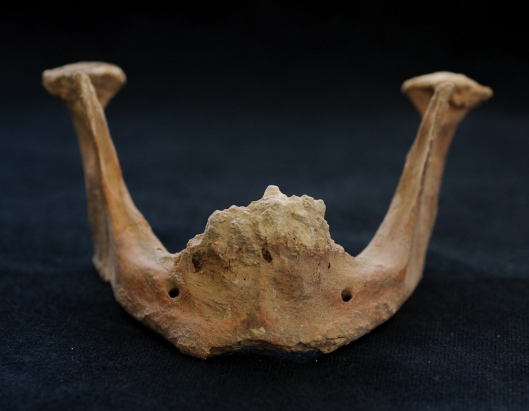
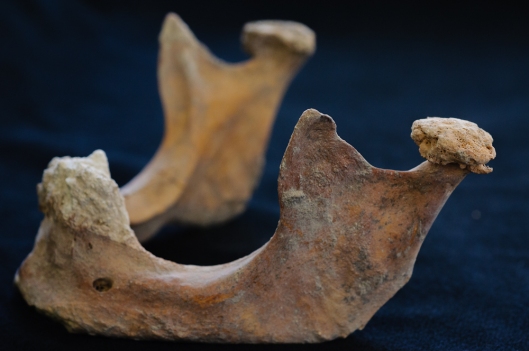

As the mother of one of the conservators, Ashley, I have enjoyed your posts immensly. Thank your for keeping us up to date!
Thank you Mrs. Lingle, I’m glad you liked my updates. Ashley and I will be leaving for home tomorrow and not a minute too soon. It’s been a long season!
best wishes,
Scott
Hi Scott,
I have never before added a comment to one of these, but wanted to acknowledge this great synopsis and what photographs!
Best regards,
Chris Knüsel
Thanks Chris!
how skull collecting could possibly have anything to do with control of local resources?
Hi Avi,
Based on ethnographic analogy, many archaeologists believe that the veneration of ancestors originated when previously nomadic peoples began to settle down in one place. Competition for local resources meant that it was necessary for groups to establish their claim to the land. One way to do this is by proclaiming descent from earlier inhabitants (i.e. ancestors) who lived on the same land. The collection and curation of skulls – some believe – is a way in which Neolithic groups demonstrated this kinship and thus their right to ownership of the land and its resources. In essence, it is a declaration that “our people were here first and we have the bones to prove it!”
Hi Scott,
Very succinct answer, nicely stated.
Best Wishes to you and Camilla,
Chris
thanks Scott!
Some cultures, still practice the veneration of ancestors, why don’t archeologists ask them ?
Hi Scott,
thank you for this up-date.
May I please ask you for the material of the plastered skull from 2004? Was it clay, gypsum or a mixture?
Best wishes
Marion
Hi Marion,
Unfortunately, the plastered skull found in 2004 was block-lifted and taken immediately to the archaeological museum in Konya at the behest of the Turkish authorities, so we didn’t have time to analyze it properly. However, the plaster on the skull appears very similar to the fine white silty-clay (marl) plasters that are typically used on internal house walls and platforms, although it could also be soft-lime, which is sometimes used as a finishing coat.
best regards,
Scott
Pingback: Dead bodies, just ‘bodies’, or bones? Thoughts on terminology when studying the past | Bodies and academia
Pingback: Nursing Clio Plastered Skulls: What can a 10,000 year old tradition teach us about coping with death?
Pingback: Bizarre Stone Age jewellery made from human teeth found in the ancient Turkish city